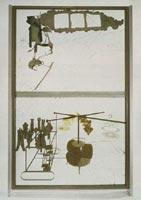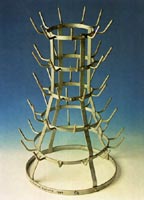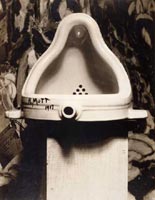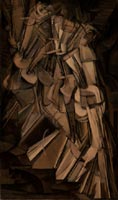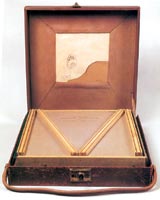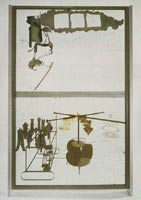The
following article is published in two parts within the exhibition (Ab)Using Marcel Duchamp: The Concept of the Readymade in Post-War and Contemporary American Art * by
Thomas Girst |
|||||||||||||||||||||||||
|
In a 1961 interview with Katherine Kuh, Marcel Duchamp, when asked about his readymades, let it be known that the concept behind those objects might be “the most important single idea to come out of my work.” (1) In June 1967, the self-proclaimed “an-artist” (2) - anticipating his final departure a mere sixteen months hence ("Quite simply, I am waiting for death") - elaborated on his concept of the readymade: “Ultimately, it should not be looked at… It’s not the visual aspect of the Readymade that matters, it’s simply the fact that it exists.… Visuality is no longer a question: the Readymade is no longer visible, so to speak. It is completely gray matter. It is no longer retinal.” When pressed by his interviewer about the paradox of the readymades having “ended up being ‘consumed’ in museums and exhibitions, and sold as art objects” (particularly in light of the editions produced by the Galleria Schwarz in Milan in 1964), Duchamp replied: There is an absolute contradiction, but that is what is enjoyable, isn’t it? Bringing in the idea of contradiction, the notion of contradiction, which is something that has never really been used, you see? And all the more since this use doesn’t go very far. If you make an edition of eight Readymades, like a sculpture, like a Bourdelle or you name it, that is not overdoing it. There is something called “multiples,” that go up to hundred and fifty, two hundred copies. Now there I do object because that’s getting really too vulgar in a useless way, with things that could be interesting if they were seen by fewer people. There are too many people in this world looking. We have to reduce the number of people looking! But that’s another matter. (3) To “reduce the number of people looking” echoes an early note by Marcel Duchamp, “Limit the no. of rdymades yearly (?).” (4) This comment, first published in the Green Box of 1934(Fig. 1), was most likely written between 1911 and 1915, during the period of the first readymades, such as the Bicycle Wheel (1913) (Fig. 2) and the Bottle Dryer (1914) (Fig. 3). (5) As he was never keen on showing them publicly, early on they may have functioned as works of private contemplation (not unlike Descartes’ famous piece of wax or William of Occam’s razor), responses, perhaps, to his note of 1913: “Can one make works which are not works of ‘art’?” (6) Accordingly, with the exception of one single New York exhibition in 1916, the readymades were unknown outside his small circle of friends and family until the 1940s. We should bear in mind that even the urinal entitled Fountain (Fig. 4) –– submitted not under Duchamp’s name, but under the pseudonym “R. Mutt” –– was rejected for display at the first exhibition of the Society of Independent Artists in 1917. Throughout his life Duchamp often declined to participate in exhibitions, especially when his readymades were involved. The Bicycle Wheel, for example, was not shown until 1951, and even then as a replica of the lost original. Duchamp is thus to be believed when he says that the readymades “were a very personal experiment that I had never intended to show to the public.” (7)
As for their actual number, Duchamp once spoke of thirty to thirty-five, though today only about a third of them are known. (8) Many objects qualifying as readymades –– mentioned in his notes and in early accounts by Charles Sheeler, William Carlos Williams, and Edgar Varèse –– were never realized or are lost without a trace. In any case, their limited number, and the fact that at least a few of them are unaccounted for, strongly suggest that they were indeed the “personal experiment” that the an-artist described. Duchamp sought from the beginning to assure that his choice of objects would be limited in order to avoid redundancy, an inevitable consequence if a larger number of original readymades had been produced. In the 1930s Duchamp declined an offer from the Knoedler Gallery in New York, whose director offered him a substantial sum if he would continue to produce the works for which he was most famous (such as the Nude Descending a Staircase of 1912) (Fig. 5). “It would force me to repeat myself. I will not even envisage this possibility. I value my independence too much.” (9) Despite the temptation, Duchamp kept the readymades out of the fray and, accordingly, they remained virtually unknown. Duchamp’s refusal to have the readymades treated as works of art led him to claim that “for a period of thirty years nobody talked about them and neither did I.” (10) His often-pronounced aesthetic indifference towards these objects also excluded the possibility of their appearance in large numbers, as that would have allowed for taste to infiltrate his “experiment.” In later years, to maintain this indifference despite their newly acquired fame, Duchamp –– always worried about the unavoidable aesthetics of patina –– thought of swapping them for newer mass-produced objects, replacing, for example, the Bottle Dryer with a plastic bucket. (11)
Outside of his notes in the Green Box, his private correspondence, and the miniatures and photographic reproductions in the Boîte-en-valise (which premiered in 1941) (Fig. 6), (12) Duchamp did not publicly mention the readymades until 1945. (13) In fact, the sole definition of the readymade published under Duchamp’s name, in 1938 –– “an ordinary object elevated to the dignity of a work of art by the mere choice of an artist” –– turns out not to have written by Duchamp but by André Breton. (14) All of the above can only hint at the intricacies of Duchamp’s early concept of the readymade and the many misreadings that followed. From the immediate post-war period until today, Duchamp’s readymades have been all too often taken as carte blanche for “anything goes,” mere nihilistic or iconoclastic gestures based on the belief that, generated by the choice of the artist, it is only the changing of the context (i.e. a urinal at a plumbing-fixture store vs. Fountain at a gallery) through which an ordinary object is transformed into a work of art. (15) Misreading Duchamp of course, is what the ambivalent an-artist himself must have anticipated and, to a certain extent, encouraged, as Dieter Daniels observed: Whenever other artists embrace the principle of the Readymade, the idea becomes completely detached from the historical objects and begins a life of its own. In so doing, it illustrates in the best way possible Duchamp’s dictum that it is the viewer who makes the pictures. The continued artistic influence of the Readymade may therefore be understood only as a permanent redefinition of its meaning. (16) Duchamp’s continuing fame, and his influence on a younger generation of artists, were unexpected: it took some time before it was established that “this whole bloody, revolutionary, contradictory century has basically been a big Duchampian-Beckettian burlesque.” (17) His own attitude towards his heirs seemed to be, at best, one of aloofness (of the same sort he had earlier professed towards Dada and Surrealism), and, at worst, frustration, as was articulated to the Dadaist Hans Richter: This Neo-Dada, which they call New Realism, Pop Art, Assemblage, etc., is an easy way out, and lives on what Dada did. When I discovered the ready-mades I sought to discourage aesthetics. In Neo-Dada they have taken my readymades and found aesthetic beauty in them, I threw the bottle-rack and the urinal into their faces as a challenge and now they admire them for their aesthetic beauty. (18) There is a problem with this infamous quote, however. Hans Richter asserted that it came straight from a letter written to him by Duchamp in 1961. Only years later did he admit that those words were not Duchamp’s. Richter had sent Duchamp this paragraph for comment, writing: “You threw the bottle rack and the urinal into their face…,” etc. Duchamp simply scrawled: “Ok, ça va très bien” into the margins. (19) In fact, the an-artist’s overall assessment of the new movements spreading all around him (and to which, to a certain degree, he owed his enormous renaissance) was, though disengaged, much more sympathetic than Richter’s misleading quote would suggest. In 1964, Duchamp, though unmoved by Pop artists’ sense of humor and choice of material, made the following favorable comments: Pop Art is a return to “conceptual” painting, virtually abandoned, except by the Surrealists, since Courbet, in favor of retinal painting… If you take a Campbell soup can and repeat it 50 times, you are not interested in the retinal image. What interests you is the concept that wants to put 50 Campbell soup cans on a canvas. (20) From the 1950s on, Duchamp’s influence on the American art scene has grown precipitously. Beginning in 1942 he lived permanently in New York, and his presence was undoubtedly a factor in the numerous exhibitions that were held in this country in succeeding years. (21) In 1952 Life magazine honored his continuing presence as “Dada’s Daddy” in a ten-page photo spread, (22) and by the mid-50s some of his readymades were permanently installed in American museums. Robert Motherwell made a significant contribution toward a Duchamp renaissance with the publication of the anthology The Dada Painters and Poets (1951), in which he characterized the Bottle Rack as at once a “sculpture” and an “anti-art and consequently dada gesture,” concluding, “it is evident, thirty-five years later, that the bottle rack he chose has a more beautiful form than almost anything made, in 1914, as sculpture.” (23) The game was on, and it certainly didn’t please everyone, least of all the Abstract Expressionists. In 1957, Barnett Newman voiced his displeasure with the Whitney Museum of American Art, particularly with Robert Motherwell’s contribution to a catalogue for the memorial exhibition of Bradley Walker Tomlin. In a letter to John I. H. Baur, the Whitney’s director, Newman accused Motherwell of “smear and slander,” stating that he wanted to “make clear that if Motherwell wishes to make Marcel Duchamp a father, Duchamp is his father and not mine nor that of any American painter that I respect.” (24) Four years earlier, in a similar tirade against the Museum of Modern Art, he had insinuated that Duchamp’s works in that institution merely added to its “popularizing role of entertainment,” and asserted “that the American public… seeks more from art than just gadgets.” (25) In 1952, he confirmed that the “gadgets” of his scorn were indeed the readymades: “Marcel Duchamp tried to destroy art by pointing to the fountain, and we now have museums that show screwdrivers and automobiles and paintings. [The museums] have accepted this aesthetic position that there’s no way of knowing what is what.” (26) This was precisely the view of Clement Greenberg, the preeminent art critic of America’s post-war era. Greenberg attacked the tendency to produce art without the guidance of aesthetic judgment, a factor many artists wanted to do away with “in the hope, periodically renewed since Marcel Duchamp first acted on it fifty-odd years ago, that by dint of evading the reach of taste while yet remaining in the context of art, certain kinds of contrivances will achieve unique existence and value. So far, this hope has proved illusory.” (27) With the advent of “Assemblage, Pop, Environment, Op, Kinetic, Erotic, and all the other varieties of Novelty Art” (28) –– all movements, that is, which were more or less indebted to Duchamp – Greenberg bemoaned not only the passing of Abstract Expressionism but of “authentic art values.” (29) These movements were fulfillments of “Duchamp’s dream of going ‘beyond’ the issue of artistic quality.” the “real failure of Pop art,” on top of its “easiness,” was its “vulnerability to qualitative comparisons,” something Duchamp had supposedly initiated in his “‘transcending’ the difference between good and bad in general.” (30) It follows that at the heart of this confusion are the readymades in their three-dimensionality, a spatial “coordinate that art has to share with non-art.” (31) That Greenberg saw the readymade as belonging to the history of painting rather than to that of sculpture clearly evolved from these observations. (32) On the other end of the spectrum, it was Duchamp himself who spoke out vividly against the movement heralded most by Greenberg: The recent examples of Abstract Expressionism clearly show the ultimate in the retinal approach begun by Impressionism. By “retinal” I mean that the aesthetic pleasure depends almost entirely on the impression on the retina, without appealing to any auxiliary interpretation… The young artist of tomorrow will refuse to base his work on a philosophy as over-simplified as that of the “representative or non-representative” dilemma. (33) In the field of art theory, similar opposing voices made themselves heard. To give but one example: early on, New York’s young and infamous art critic Gene Swenson rejected the tradition that linked everything from Cubism to Color Field painting and instead proposed a different trajectory declaring Dada and Surrealism the ancestors of Pop. In 1966, he curated the exhibition “The Other Tradition” at the Philadelphia Institute of Contemporary Art. According to the catalogue, the show’s declared goal was “1) seeing certain twentieth-century works of art which have been overlooked or neglected by art historians, and 2) suggesting alternative ‘intellectual’ rather than formal ways of dealing with this art.” Swenson’s checklist is topped off by four contributions from Duchamp, leading him to ask: “How much longer will we rest content with our defective and infectious critical tools and our academic standards? How many more times can we see the words ‘picture plane,’ ‘modernism,’ ‘crisis,’ new,’ and ‘literary’ without flushing?” (34) Swenson was reacting to a paradigmatic shift in American art, and many young artists were enthralled to find out that Duchamp’s newly discovered oeuvre spoke to their own strategies of subverting what came before them. He was simply “in the air,” (35) as Bruce Nauman put it. John Cage began lecturing on Duchamp at Black Mountain College (starting in 1952) as well as at the New School of Social Research (1956-58), to a new generation of artists that included Robert Rauschenberg, George Brecht, Alan Kaprow, Al Hensen, Dick Higgins, and Jackson McLow. George Segal remarked that “Marcel Duchamp had a revived life through John Cage.” (36) In 1958 Rauschenberg and Jasper Johns went to see the Duchamp collection at the Philadelphia Museum of Art. Years before, during the War years, Joseph Cornell had befriended Duchamp in the course of his collaboration on the latter’s Boîte-en-valise. Yet to comprehend fully the scope of Duchamp’s deep appreciation by post-war generation and contemporary American artists as well as the influence he wielded over them –– especially with his readymades –– nothing serves the purpose better than to hear it in their own words (37) : Robert Motherwell “I would say that one of the most astonishing things in my lifetime as an artist is his prominence. Thirty years ago, if somebody had said to me, ‘he may become the major the major influence on the art scene,’ I’d have said: ‘You’re out of your mind,’ and most of my judgments were quite accurate then.” - Vivien Raynor, “A Talk with Robert Motherwell,” Art News, vol. 73, no. 4 (April 1974). p. 51, quoted in: Dieter Daniels, “Marcel Duchamp: The Most Influential Artist of the 20th Century?,” in: Museum Jean Tinguely Basel (ed.) Marcel Duchamp, Ostfildern: Hatje Cantz, 2002 [exh. cat.], pp. 37-40, pp. 25-33, p. 25. Barnett Newman I want particularly to make clear that if Motherwell wishes to make Marcel Duchamp a father, Duchamp is his father and not mine nor that of any American painter that I respect.” - in a letter to John I. H. Baur, October 20, 1957, quoted in John P. O’Neill (ed.), Barnett Newman: Selected Writings and Interviews, New York: Alfred A. Knopf, 1990: p. 208. George Segal “Marcel Duchamp had a revived life through John Cage.” - cited by Wouter Kotte, Marcel Duchamp als Zeitmaschine/Marcel Duchamp als Tijdmachine, Köln, Verlag der Buchhandlung Walter König, 1987: p. 86, n. 236. John Cage “It is astonishing how very much Marcel Duchamp makes others creative” - cited by Serge Stauffer in: Thomas Zaunschirm, Bereites Mädchen Ready-made, Klagenfurt: Ritter, 1983, p. 10., quoted in: Marcel Duchamp: The Most Influential Artist of the 20th Century?,” p. 27. “Say it’s not a Duchamp. Turn it over and it is.” - “26 statements Re Duchamp” (1969), in: Susan Hapgood, Neo-Dada: Redefining Art 1958-62, New York: The American Federation of Arts, 1994 [exh. cat.], p. 137. Nam June Paik “Marcel Duchamp has already done everything there is to do – except video…only through video art can we get ahead of Marcel Duchamp.” - interview with Irmeline Lebeer, in: Chroniques de l’art vivant, nr. 55 (February 1974), p. 35, quoted in: “Marcel Duchamp: The Most Influential Artist of the 20th Century?,” p. 27. Robert Morris “The Readymades are traditionally iconic art objects” - “Notes on Sculpture 4: Beyond Objects” (1969), in: Charles Harrison and Paul Wood (eds.), Art in Theory: 1900-1990. An Anthology of Changing Ideas, Oxford and Cambridge, MA: 1992, vol. 2, p. 872, quoted in: “Marcel Duchamp: The Most Influential Artist of the 20th Century?,” p. 30. Joseph Kosuth “The event that made conceivable the realization that it was possible to ‘speak another language’ and still make sense in art was Marcel Duchamp’s first unassisted Readymade. With the unassisted Readymade, art changed its focus from the form of the language to what was being said…This change – one from ‘appearance’ to ‘conception’ – was the beginning of ‘modern’ art and the beginning of conceptual art. All art (after Duchamp) is conceptual (in nature) because art only exists conceptually.” - “Art after Philosophy” (1969), in: Art in Theory: 1900-1990. An Anthology of Changing Ideas, p. 844, quoted in: “Marcel Duchamp: The Most Influential Artist of the 20th Century?,” p. 30. Allan Kaprow “[Duchamp] deliberately stopped making art objects in favor of little (ready-made) hints to the effect that you could pick up art anywhere you wanted. In other words, he implied that the whole business of art is quite arbitrary” - “Interview with Allan Kaprow,” Allan Kaprow, Pasadena: Pasadena Art Museum, 1967 [exh. cat.], p. 8, quoted in: John Tancock, “The Influence of Marcel Duchamp,” in: Anne d’Harnoncourt and Kynaston McShine (eds.), Marcel Duchamp. A Retrospective Exhibition, Philadelphia: Philadelphia Museum of Art, 1973 [exh. cat.], pp. 160-178, p. 171. “His readymades… are radically useful contributions to the current art scene. If a snow shovel becomes a work of art by simply calling it that, so is all of New York, so is the Vietnam war, so is a pedantic article on Marcel Duchamp… The Readymade is a paradigm of the way humans make and unmake culture. Better than ‘straight’ philosophy and social science, a good Readymade can ‘embody’ the ironic limits of the traditional theory that says reality is nothing but a projection of mind or minds. ” - “Doctor MD”, in: “A Collective Portrait of Marcel Duchamp,” quoted in: Anne d’Harnoncourt and Kynaston McShine (eds.), Marcel Duchamp. A Retrospective Exhibition, Philadelphia: Philadelphia Museum of Art, 1973 [exh. cat.], pp. 204-205, p. 205. “I think we all learned from… Duchamp. A key feature was discreetness, a timing and a restraint that many of us didn’t learn well enough. Duchamp was personally very helpful to us, no question… both practically and intellectually.” - interview with Susan Hapgood, quoted in: Neo-Dada: Redefining Art 1958-62, p. 116. Vito Acconci “Did this film [Conversions of 1971] record a process parallel to the multivalence between Marcel Duchamp and Rrose Sélavy? ” “Yes. ” - interview with Robert Pincus Witten, "Vito Acconci and the Conceptual Performance," in Artforum, vol. 10, nr. 8 (April 1972), p. 49, quoted in: John Tancock, “The Influence of Marcel Duchamp,” p. 178. William T. Wiley “What we can learn from Marcel Duchamp is the same message from any artist who has made his presence manifest in the form of personal achievement: is essentially that we do not have to follow his example. Yet should we find in his example a path that interests us we should trust ourselves enough to follow that path as long as it is possible without an overabundance of human misery” - “Thoughts on Marcel Duchamp,” in: Brenda Richardson, Wizdumb: William T. Wiley, Berkeley: University Art Museum, 1971, p. 42, quoted in: “The Influence of Marcel Duchamp,” p. 173. Paul Pfeiffer “Somewhere I read a statement by Duchamp to the effect that his art was intended as a destroyer, specifically of identity. I find that really inspiring. Putting a mustache on Mona Lisa makes a pretty basic point about the fluidity of identity and the depths to which gender, race and nationality are encoded into vision. I’m interested in multiple meanings and a kind of ambiguity that frustrates any attempt to pin it down.” - Linda Yablonsky, “Making Microart that can Suggest Macrotruths,” in: The New York Times, December 9, 2001, p. 39. Richard Pettibone “My response to Duchamp hasn’t changed at all in the last 34 years. His work is just as beautiful. Being a visual artist I feel that it’s very important what things look like & in spite of all that talk about chance & giving up taste, etc. Duchamp’s work is still drop dead gorgeous.” - letter to Francis M. Naumann, August 1997, quoted in: Francis M. Naumann, Apropos of Marcel. The Art of Making Art after Duchamp in the Age of Mechanical Reproduction, New York: Curt Marcus Gallery, 1999 [exh. cat.], p. 13. Sanford Biggers “Duchamp’s readymades are now aesthetically and formally pleasing, though they were controversial for their time and opposed the conventions... I also follow the idea of keeping the form as one of the most important elements but also feel strongly about challenging prescribed notions in art theory. The fact that I am the creator or author of these pieces also adds to how these pieces are interpreted by art theory.” - Lauren Wilcox, “Transformation and Tradition: Interview with Sanford Biggers,” in: Tout-Fait: The Marcel Duchamp Studies Online Journal, vol. 2, nr. 4, Art & Literature (January 2002),<http://www.toutfait.com/issues/volume2/issue_4/ArtandLiterature/bigger/bigger.htm> >>Next
page 1 2
Notes
[15] George Dickie, Art and the Aesthetic. An Institutional Analysis, Ithaca and London, Cornell UP, 1974: pp. 38-39.
[33] Marcel Duchamp, “Where Do We Go From Here?,” address to a symposium at the Philadelphia Museum College of Art, March 1961, in Anthony Hill, ed., Duchamp: Passim. A Marcel Duchamp Anthology, Langhorne, PA: G+B Arts International, 1994, p. 89. Duchamp seems to have had an unfavorable opinion of Abstract Expressionism’s major player, Jackson Pollock. According to Thomas B. Hess, Duchamp “complained” to him that Pollock “still uses paint, and we finished that… [Pollock] never will enter the Pantheon!” (Hess, “J’accuse Marcel Duchamp,” in Joseph Masheck, ed., Marcel Duchamp in Perspective, Englewood Cliffs, Prentice-Hall, 1975: p. 120). Duchamp had declared painting dead with his last oil on canvas, Tu m’ from 1918. In regard to Pollock, there is yet another anecdote worth telling: In 1945, Peggy Guggenheim called in Duchamp and David Hare to deal with a crisis involving a twenty-foot-long mural by Pollock. The mural was too long for the space it had been commissioned to fill, in the entrance hall of Guggenheim's apartment. Duchamp coolly advised cutting eight inches off one end. According to Hare, “Duchamp said that in this type of painting it wasn't needed” (Calvin Tomkins, Duchamp: A Biography, New York, Henry Holt, 1996: p. 362).
Fig.
1-7
|
|||||||||||||||||||||||||
